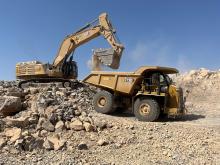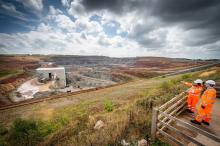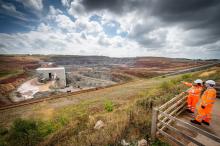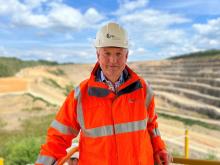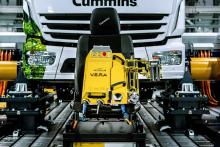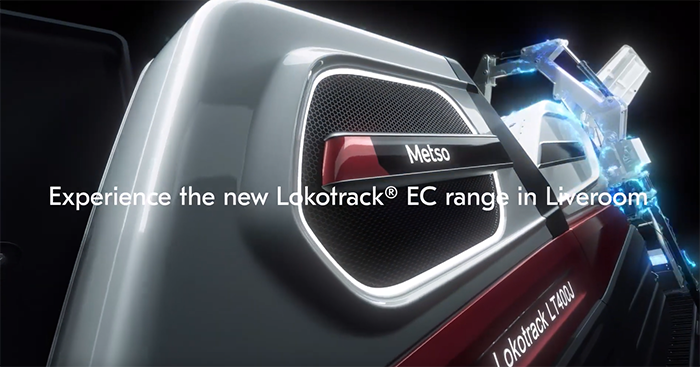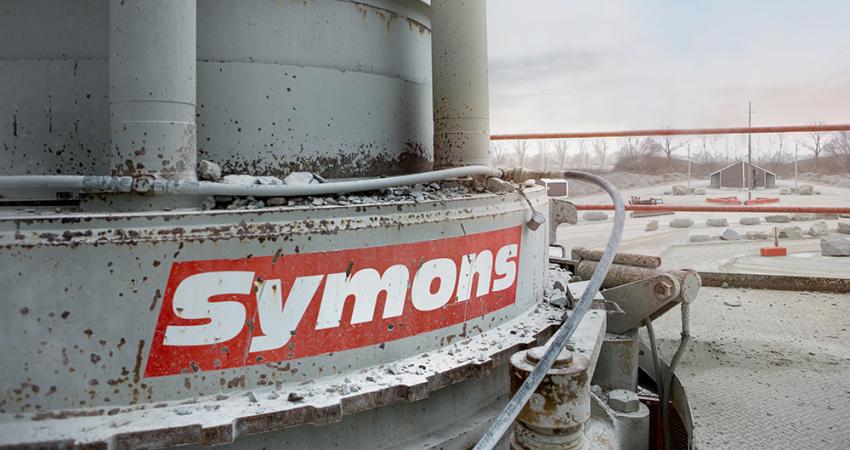
Gary Martin is a Caterpillar Senior Market Professional, one of only a few given the title by the world's biggest off-highway equipment manufacturer for their wealth of experience and in-depth knowledge of the industries they serve, including quarrying, mining, and construction. He spoke to Guy Woodford about his wide-ranging role, which sees him travel the world assisting customers and colleagues while also working closely with Cat dealer Zahid Tractor in Saudi Arabia and Al-Bahar in the UAE (United Arab Emirates) who are based next to Martin's now firmly established home in Dubai.
Gary Martin paints a vivid picture when discussing life in Dubai, including when asked to describe what he saw in the Emirate when he first visited in 2002.
"The Burj Khalifa [at 829.8m, the world's tallest building] was 40 metres down, not up – on a big open ground site. Today, Dubai Marina has 200 towers, but only two or three were completed back then. In the early 2000s, Dubai had the world record for the most tower cranes in one area. Business deals were done after establishing trust, and payments were made by chequebook or even cash. Now, all business transactions are done electronically. It's changed so much."
At the start of this century, it was also a very different world regarding health and safety in UAE quarries. "You would see people walking around wearing no PPE [personal protection equipment] on site. It would also be typical to see site workers wearing flip-flops," remembers Martin. "There were open cabs on the machines, with dust everywhere, and air conditioning was a dream on many machines.
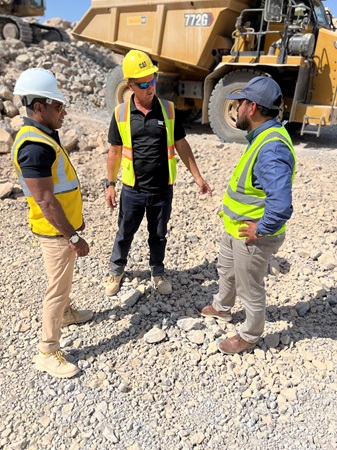
"Because quarrying evolved so quickly back then, companies you'd never heard of were starting a site and winning contracts to meet the huge demand for construction materials and rock to build the islands within the Persian Gulf."
Martin took on the Senior Market Professional role after leaving the Caterpillar Malaga Demonstration & Learning Centre in Spain, where he worked as a senior demonstrator instructor, helping Cat customers run their equipment fleets more efficiently to reduce their overall cost per tonne.
"There were only two of us at the beginning in application roles and I spent most of my time with customers based in Africa, the Middle East and some parts of Asia. It made sense to put us both somewhere more globally central than in Europe. We looked at having one of us located in Johannesburg, South Africa, and one in Dubai, but we still had to cover a much wider area, including Europe. Since Dubai was a global air travel hub, it made sense for us to be based there.
"I remember going to Dubai for an operator training event and fell in love with it. My partner, now my wife, and I had lived in Malaga for eight years, and she was surprised when I came back and told her I'd found somewhere even better for us."
Martin enjoyed the quality of life in Dubai during his first years of being based there, after his move from Malaga in February 2010, as the UAE was experiencing the fallout from the 2008-2009 global financial crisis.
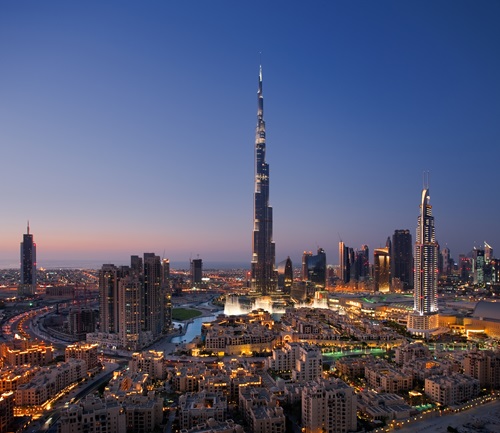
"Before 2009, if you wanted to go to a restaurant in Dubai, you had to book it three weeks in advance, and they only held your table for 15 minutes! Then, the financial crash hit, and people started leaving in droves. In 2010, you could call the restaurant the day before you wanted to eat, and you might call to say you would be an hour late, and they'd say, 'Not a problem'. When we first moved to Dubai, the city was built and ready to go, but barely anyone was around.
"From an off-highway equipment market perspective, it was dead. Many reports told of businessmen driving their Ferraris, Lamborghinis and other expensive cars to Dubai Airport and leaving them parked outside the airport terminal as they flew elsewhere."
Martin says investors and businesses started returning in large numbers to Dubai and the rest of the UAE in 2011. "It was like the person who had turned off the light switch in 2009/2010 had turned it back on. The market comeback was rapid. There was a big UAE quarrying industry reset in 2011 going into 2012. All the smaller ad hoc quarrying companies that had appeared disappeared very quickly. There were new health and safety laws and regulations. Everyone was now looking at what each other was doing and raising their game. Big international quarrying companies had come in, emphasising health and safety strongly, adhering to regulations set by the likes of OSHA [The Occupational Safety and Health Administration] in the United States. Many European quarry industry professionals were also coming here. You began seeing companies appointing site safety officers and taking health and safety very seriously."

In his Senior Market Professional role, Martin, a UK national who grew up in Barrow-in-Furness, northwest England, mainly works with Cat larger quarrying and heavy construction customers and the Cat dealer global network. His vast geographical area of responsibility includes Europe, Africa, the Middle East, part of Eurasia and several major countries in Asia-Pacific. "I cover around 70 per cent of the world in my role. My time spent in each region is very much based on weather trends. The peak time for work here in the Middle East is the winter and spring; as the heat drops off, you can get out and stand on-site talking to people. I am in and out of Asia in the first or last half of each year, carefully avoiding monsoon season. It's the same with Africa, whose rainy season runs from June to September. I often go to Europe and Eurasia in the summer when you can get on-site easily."
How does he see customer quarrying and heavy construction equipment and building materials demand in each region he serves? "In the UAE, there's work off the coast of Abu Dhabi. They are building islands within the Persian Gulf to extract buried gas deposits. We're also seeing quarried material being taken up to Abu Dhabi. At these sites, excavators are very popular because of their flexibility. In quarries, 50-tonne and above large excavators are now seen as standard.
"In Saudi Arabia, there's a greater on-site equipment mix with large wheeled loaders and excavators. Saudi Arabia has many megaprojects underway, like the World Cup and the Red Sea project, to name just a few, which are worth billions of dollars.
Turning his attention to Africa, Martin continues: "On the West Coast, a lot of the materials the region's quarries produce seem to be used internally. The African East Coast is seeing infrastructure work like highways, railways and dams in those countries. There's a lot of investment by the Chinese. Sometimes, the Chinese contractors need to buy and use equipment built in China, which we can provide.

"In South Africa, mining contract customers remove overburden and put haul roads in or are hired to do the load and haul work from the [mine] face. Typically, those customers want large dump trucks up to 100 tonnes and large excavators."
"In Asia, much of the quarrying is small scale. Customers are taking 40-tonne dump trucks and 50-tonne excavators. It's mainly an excavator market." but there are also many large construction projects."
Martin says that he and Cat dealer colleagues are seeing a lot of repeat quarrying and heavy construction equipment buying around nomenclature. "If a customer has, for instance, had Cat 966s [wheeled loaders] before, they will buy them again. If they already have our 390s [excavators], they'll buy the 395s. It's the same with our dozers, the D8s and D9s. This is a trend in the UAE and most other parts of the world. In South Africa, customers are willing to try equipment of different sizes outside the normal nomenclature."
Martin says that while quarrying customers are generally not looking to rent their machines, heavy construction customers are increasingly doing so. "There are peaks in timelines on many projects. Rather than buying extra machines for those project peaks, a customer may rent a large fleet for a year and then return them. Perhaps 70 per cent of a machine fleet is always needed, and 30 per cent is rented for specific projects. It's also peace of mind that if anything goes wrong with your rented machines, you are covered with a unit immediately being delivered.
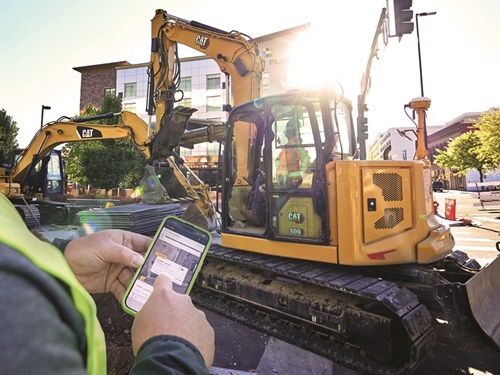
"On the quarrying side, you know your production level and how many loads you must take to the crusher. There is more operating certainty."
So, how is Caterpillar looking to grow its business with quarrying and heavy construction customers? "The investments Caterpillar is making are about helping customers better understand the capabilities of the machines and data coming back off them to enhance their operations."
Critical to this is customers' use of VisionLink® and VisionLink Productivity, which wirelessly connect customers to their equipment, giving them valuable insights into how their machines or fleet performs. Information such as location, hours, fuel usage, productivity, idle time, and diagnostic codes are available through online web applications accessible on a desktop, laptop or mobile device, allowing customers to make timely, fact-based decisions to help maximise efficiency, improve productivity, and lower the cost of owning and operating a fleet.
"Many customers that have had VisionLink for years are using it far more now," says Martin. "The platform has changed so much in the last five years. The data you can get from it, depending on your subscription [VisionLink Productivity offering the most actionable data for site and equipment operations], is phenomenal. Regardless of equipment manufacturer or fleet size, customers can find value in connecting their machines to VisionLink. For instance, you can see where your equipment is parked and how long it's been parked. You can see what time of day it was parked. Was the engine running at that time? You can start to see trends in what your current machine fleet is doing rather than automatically buying more machines to reach production targets.
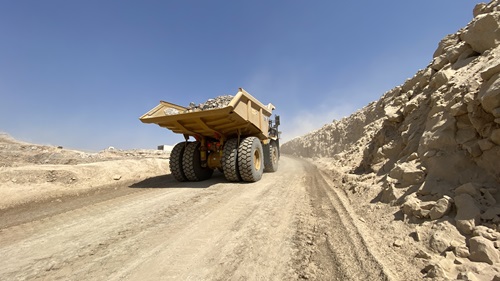
"Some customers now employ people to monitor and report back on the performance of their machine fleet and identify operating trends. It's similar to Cat dealerships, where specialists remotely monitor the health of customers' machines. Martin stresses that while customers can access machine production and efficiency data, they need people to interpret it and, when necessary, go outside the business to address anything wrong.
"This is where customer fleet servicing and maintenance comes in via Cat Customer Value Agreements [CVAs]. There are different levels of these, from simple preventive maintenance kits to total maintenance and repair agreements. The Fuel Promise Programme is another benefit of having a new machine under a CVA. Quarry customers can have, for example, a fleet of D8s [dozers], with the assurance that they will not consume more than X litres of fuel per hour. This is available in every country where the machines provide data. VisionLink is also part of our CVAs."
"Depending on their VisionLink subscription, customers will also get weekly, fortnightly or monthly fleet performance reports. These reports provide an anonymous comparison with other customers in the region. The comparison covers estimated idling, fuel burn, working hours, and much more. If the results are unsatisfactory, the customer concerned might want to consult with their Cat dealer on how best to improve with the support of one of our dealer or Cat application specialists."
"For larger projects, I may go with an application specialist and a Cat dealer representative to the customer job site, observe their operation for a day or two, and then propose some changes. Once the changes have been implemented, we present a report to show the customer what has improved and how we did it. As part of this, we may consider total or partial machine rebuilds to give key models a second life or replace certain machines with new ones to help them deliver a particular project. We may return to that customer's job site three or four times a year, ensuring that operational changes are being followed. It's about whatever works best for the customer."

Asked what quarrying and heavy construction customers he works with are doing to reduce their carbon footprint and improve the wider sustainability of their businesses, Martin says: "In the UAE and Saudi Arabia, some customers are looking for electric-powered machines. Many customers are investing in electrified [on-highway] car fleets. One large customer has changed all his company fleet cars to Tesla to reduce emissions within his company.
"In the Gulf, many quarries and construction projects have machines running on Euro 5 [emissions standard] diesel. In Saudi Arabia, Euro 5 diesel is also being delivered. Today, a wide range of Cat generators run on biofuel, which many customers are using.
"This region is changing. Sustainability is becoming a priority. Everywhere you go in the UAE, there are charging points for electric cars, and they are free. They also love technology here. They are talking about introducing pilotless flying taxis from 2025 within the UAE."
We are speaking on Microsoft Teams in early December 2023, with Martin having recently returned to Dubai after playing a key role in a big global customer event at the Caterpillar Demonstration & Learning Centre in Malaga.
Martin plays a key role in developing a series of global training programmes to leverage on-board and off-board technology to help customers in quarry and heavy construction operations lower their cost per tonne by evaluating the sites in real-time using vital data and technology.
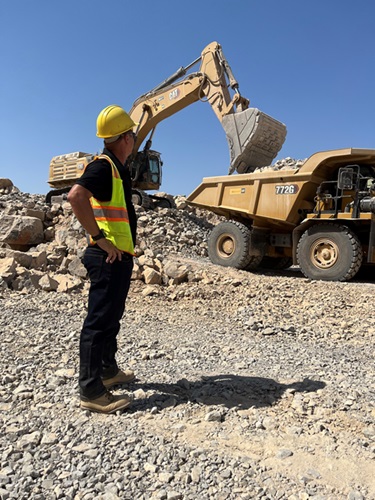
"The job has changed tremendously in the last twenty years. In the past, I used to spend three days to a week on-site to gather information and understand the operation. Today, we have access to a high volume of information without leaving the office for the most part; it is easier than ever to help customers improve their site operations."
Even though Martin finds time to mentor and train less experienced colleagues or his peers, he stresses that sometimes you "just have to be there" with customers and dealers. "The demand for the services of a Caterpillar Senior Market Professional is very high. You must ensure that key messages and advice have been understood, and you really cannot beat face-to-face contact to understand firsthand what the challenges are and to establish strong relationships."
I end by asking Martin what he likes so much about his work. "Every day is different. Different questions are coming back to you, and you have to think things through. I never feel stale like you can do in many repetition-based jobs. I have customers all over the world who are also very good friends. I always want to know how they are getting on in delivering their projects. Although I currently cover 70 per cent of the world, I look forward to continuing to grow my career and serving customers around the world as a Market Professional."

